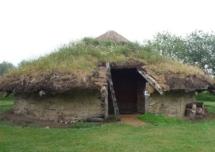Archaeologists in Oban discover Bronze Age was height of cool
Moira Kerr
Source - http://www.scotsman.com/news/scottish-news/top-stories/archaeologists-in-oban-discover-bronze-age-was-height-of-cool-1-2335347

Workers at the Burnt Mound area at the Dunstaffnage site
They had fridges, state-of-the-art heating systems and possibly even access to a sauna. Archaeologists have discovered that Bronze Age people, at a settlement on the west coast of Scotland dating back up to 4,000 years, had a range of mod cons that would be envied by home owners today.
A dig on the site of a new housing development near Oban has uncovered what are believed to be some of Scotland’s earliest cold storage larders in six Bronze Age roundhouses. A team led by Dr Clare Ellis, from Argyll Archaeology, claim the roundhouses at Dunstaffnage are the first in Scotland to have ring ditches inside the structure. These may have been used as cellars to cool food – a precursor to the refrigerator.
They also have vents leading into the central hearths which would have allowed the occupants to regulate their heating, while outside are the remnants of what could be a very simple form of sauna.
But Ellis said the most significant find was the internal ring ditches. “This is a new design, not recognised or seen before in Scotland. The general consensus until now was that ring ditches occur outside the roof supports of roundhouses, but still within the roundhouse structure, and were erosional features where animals were kept. But these are inside the roof support area and the theory is that they are low cellars that would have had wooden floors over them. We think they are an early form of larder storage system.
“In the Iron Age they had banana-shaped cellars and this would appear to be the precursor to that. They are on the north-east side, the coolest side of the house [away from the sea]. It’s like an early form of refrigeration, where they would keep cheeses, milk, dried meat, salted fish and grain.”

Ellis, 43, said another important find, in terms of Scottish archaeology, was the discovery of air vents coming out of the ring ditches and the hearths.
She added: “These channels coming out are wood-lined vents to let air through and to allow the washing-out of some of the ring ditches occasionally. This is a new design that’s not really been recognised or seen in Scotland before.” The vents in the hearths would allow air to be channelled into the base of the fire.
As well as uncovering the roundhouse sites, the team has uncovered ancient burial pits. Other finds include a hammerstone, dating back 3-4,000 years, which would have been used for mashing up vegetable matter.
In addition, a flint, imported or traded from Ireland, has been found in a burial pit, along with several pieces of decorated pottery thought to be from pots used to lay to rest cremated human remains.
The area around Oban is believed to have been well populated by Bronze age man because of its sheltered climate. Settlements have been found throughout the area and at Dunstaffnage, about four miles to the north, where communities were built on the flat terraces overlooking the Firth of Lorn.
The recently discovered roundhouses were originally enclosed by a ditch, which dates back earlier than the actual homes. A burnt mound has been uncovered at the site. This was an area where water was heated, with some theories suggesting this was an early form of sauna.
The finds all date back to the Bronze Age but radio carbon dating will be used to determine a more accurate date for the settlement, to within 40 years.
Ellis said: “It’s unusual to get so many roundhouses surviving together in this way. They are not particularly huge so they were probably just ordinary people living here. They would have been farming – and communication would have been by sea, rather than by land. It’s a good spot. There is a lovely sheltered bay here and you have got all the islands, like Lismore and Mull nearby.”
Historian Catherine Gillies said the area was turning up “some vastly important sites. You only have to look at the scattering of Bronze Age and Iron Age sites in places like the isle of Lismore to see that we are genuinely only scratching the surface of what there is.”
Affordable housing is to be built at the site by West Highland Housing Association. Lesley McInnes, the association’s chief executive, said: “Whilst we are looking to develop the site we are going to look at having something there in the future that would be able to bring the past to life.”